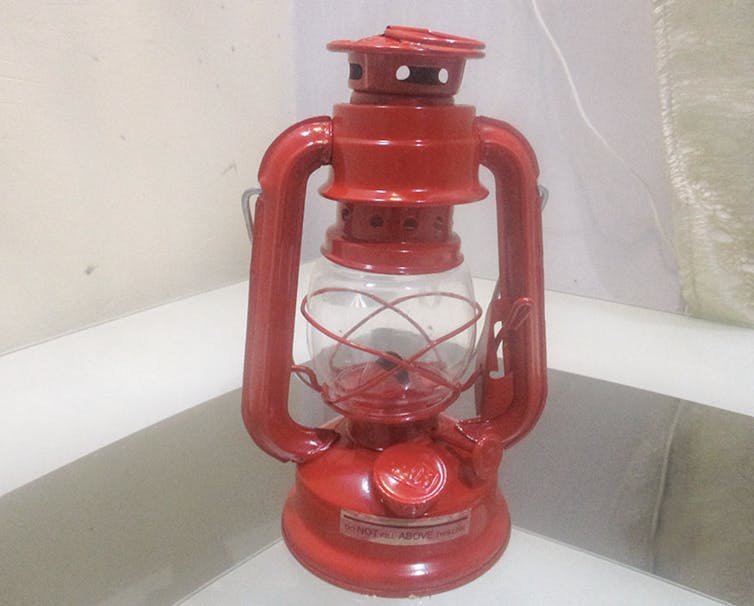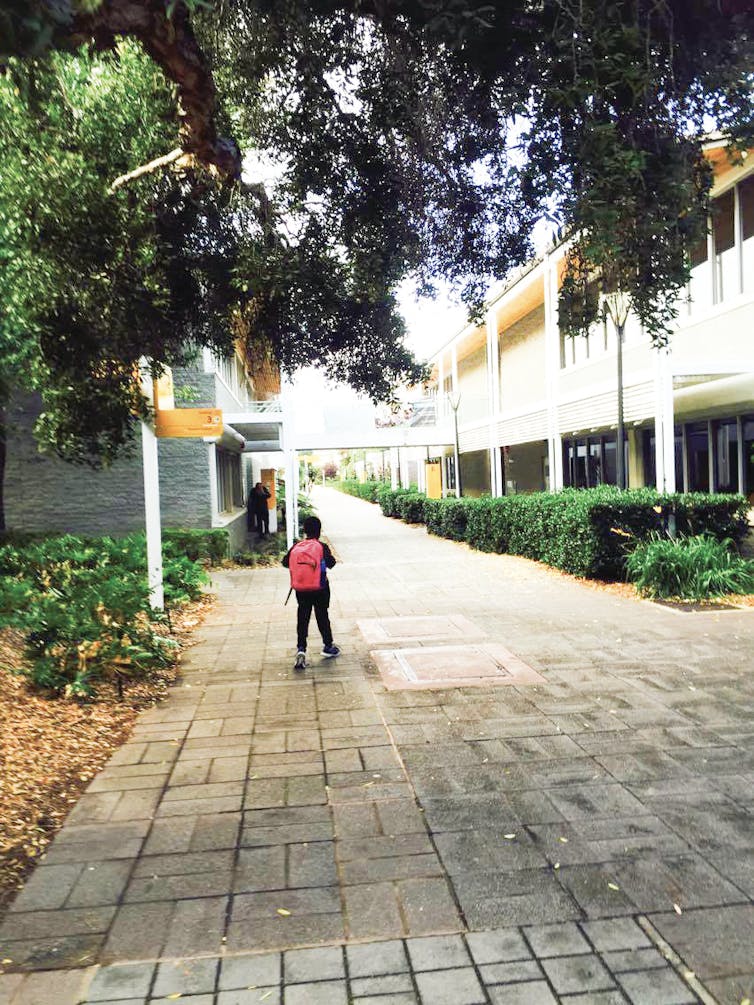How a photo research project gives refugee women a voice in resettlement policy
- Written by Jaya A R Dantas, Dean International, Faculty of Health Sciences and Professor of International Health, Curtin University
Between 2000 and 2017, the number of refugees and asylum seekers globally increased from 16 to 26 million. In 2016, women made up 49% of global refugees. Dominant representations of refugee women are that of vulnerable and helpless victims. This disregards women’s agency, voice, and deep desire for education and social enterprise.
Australia’s refugee intake is expected to increase to 18,750 in 2018-19, the largest intake in 30 years. In 1989, Australia established a “Woman at Risk” visa subclass for women and their dependants living outside their home country who have been subject to persecution because of their gender. Over 1,600 visas were granted in 2016-17 to vulnerable women and children.
Upon resettlement, women may face challenges such as language difficulties, isolation, health issues, loss of family and support networks, violence and discrimination. These women’s voices can be excluded in forming policies, with significant impacts. Research approaches which explore issues related to settlement from their perspective are needed to effectively inform settlement policy and programs.
The research
Our research explored refugee women’s perspectives on settlement in Australia. We conducted the research in partnership with Ishar Multicultural Women’s Health Centre in Western Australia.
We used the participatory education research method of photovoice, which has become increasingly popular in health research with marginalised groups globally. It’s used as a tool for empowering participants in Costa Rica, enhancing their self-perception in Canada, building their networks in Spain, and supporting cultural resilience and influencing policy in the US.
Read more: #AllWomenCount: art and culture at the forefront of World Refugee Day
Participants were provided with cameras and asked to photograph situations that represented their settlement experiences. Some 43 women participated in six small group sessions with a professional photographer. Training included the ethics of taking photographs, selecting topics, and photography practice.
Discussions of their images used the “SHOWeD” technique, a form of critical questioning which explored the stories behind their photos. This led to reflective recommendations for supporting successful settlement. We also conducted in-depth interviews with 11 women to explore their experiences of settlement issues and the photovoice method.
The power of photographs and narratives
Our participants selected photographs and wrote accompanying narratives for an exhibition which has been travelling across public libraries. This project highlights the challenges of their lives in Australia, the importance of family and social support, the need for education and employment and drawing on personal strength during resettlement.
 Author provided, Author provided
Light and warmth in war
Light makes me feel safe. War took all the light from our lives. We used this light to survive and hold us together.
–Alma
Author provided, Author provided
Light and warmth in war
Light makes me feel safe. War took all the light from our lives. We used this light to survive and hold us together.
–Alma
 Author provided, Author provided
Road to life: leaving weary worlds behind
The road represents the difficulties of life before coming to Australia. The turning point in my life came and I was able to overcome the difficulties of life with help from support organisations.
–Annie
Author provided, Author provided
Road to life: leaving weary worlds behind
The road represents the difficulties of life before coming to Australia. The turning point in my life came and I was able to overcome the difficulties of life with help from support organisations.
–Annie
 Author provided, Author provided
Happy times
My son is going to the library. It is important to me because in my country it was not possible for children to go safely to the library or school. In Australia, my children can have the opportunity to be educated, which is something I did not have. I enjoy being part of my son’s school.
–Gabriella
Sustained English language education
Settlement is a long, non-linear process and is shaped by intersecting factors including gender, age, ethnicity and education. English language proficiency is a key facilitator to successful settlement. But many women face competing priorities in accessing English language education when they resettle in Australia, including child care responsibilities and attending to the health needs of family members.
Refugee women need sustained access to English language tuition which takes into account their circumstances and immediate needs. Education and language programs need to be flexible, through access to home tutoring or childcare.
Read more:
Universities need to do more to support refugee students
This recommendation was also made in a recent parliamentary inquiry into migrant settlement outcomes. It was also discussed in research on empowering migrant and refugee women.
Our participants reported personal benefits from taking part in the photovoice project. They enjoyed learning in small group settings and their confidence increased after talking in a group. They felt a sense of well-being sharing their successes and challenges, learned new skills and knowledge, and felt empowered sharing their resettlement journeys.
Five recommendations to support settlement
Our recommendations are drawn from the refugee women themselves and grounded in research. We propose:
promoting strength-based approaches to support service delivery, that are sensitive to cultural differences
English language programs for refugees need to be responsive to the gendered circumstances of women
we support changes proposed by the Refugee Council of Australia to make family reunion accessible to women and their families
refugee women should be supported to gain education and employment through training, peer mentoring, learning entrepreneurial skills and building networks
approaches to building social cohesion and combating racism and discrimination from the local to Federal political levels need to be formalised.
Our research has highlighted barriers to successful settlement by locating refugee women’s experiences in a broader Australian social and political context. Women’s resilience and agency should be considered in the development of policy, programs and service delivery.
Refugee women are often left out of the conversations around resettlement, and not enough is known about their specific needs. Our research and the international photovoice research highlights that community-based participatory education methods (such as photovoice) are an effective way to meaningfully add the voices of refugee women to the wider discourse on migration and settlement.
Author provided, Author provided
Happy times
My son is going to the library. It is important to me because in my country it was not possible for children to go safely to the library or school. In Australia, my children can have the opportunity to be educated, which is something I did not have. I enjoy being part of my son’s school.
–Gabriella
Sustained English language education
Settlement is a long, non-linear process and is shaped by intersecting factors including gender, age, ethnicity and education. English language proficiency is a key facilitator to successful settlement. But many women face competing priorities in accessing English language education when they resettle in Australia, including child care responsibilities and attending to the health needs of family members.
Refugee women need sustained access to English language tuition which takes into account their circumstances and immediate needs. Education and language programs need to be flexible, through access to home tutoring or childcare.
Read more:
Universities need to do more to support refugee students
This recommendation was also made in a recent parliamentary inquiry into migrant settlement outcomes. It was also discussed in research on empowering migrant and refugee women.
Our participants reported personal benefits from taking part in the photovoice project. They enjoyed learning in small group settings and their confidence increased after talking in a group. They felt a sense of well-being sharing their successes and challenges, learned new skills and knowledge, and felt empowered sharing their resettlement journeys.
Five recommendations to support settlement
Our recommendations are drawn from the refugee women themselves and grounded in research. We propose:
promoting strength-based approaches to support service delivery, that are sensitive to cultural differences
English language programs for refugees need to be responsive to the gendered circumstances of women
we support changes proposed by the Refugee Council of Australia to make family reunion accessible to women and their families
refugee women should be supported to gain education and employment through training, peer mentoring, learning entrepreneurial skills and building networks
approaches to building social cohesion and combating racism and discrimination from the local to Federal political levels need to be formalised.
Our research has highlighted barriers to successful settlement by locating refugee women’s experiences in a broader Australian social and political context. Women’s resilience and agency should be considered in the development of policy, programs and service delivery.
Refugee women are often left out of the conversations around resettlement, and not enough is known about their specific needs. Our research and the international photovoice research highlights that community-based participatory education methods (such as photovoice) are an effective way to meaningfully add the voices of refugee women to the wider discourse on migration and settlement.
Authors: Jaya A R Dantas, Dean International, Faculty of Health Sciences and Professor of International Health, Curtin University





